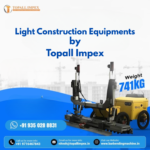When it comes to managing construction budgets, buying used light construction equipment can be a smart financial move. However, purchasing pre-owned machinery comes with its own set of risks. If you’re not careful, you might end up with a machine that costs more in repairs than it saves in purchase price.
To help you make an informed decision, this guide outlines everything you need to inspect before buying used light construction machines—ensuring your investment is both cost-effective and reliable.
Why Buy Used Light Construction Equipment?
Before diving into the checklist, let’s briefly discuss why used equipment is popular in the construction sector:
-
✅ Lower upfront cost
-
✅ Shorter lead time for delivery
-
✅ Great for short-term or one-time projects
-
✅ Reduced depreciation
-
✅ Ideal for small contractors or startups
However, these benefits only hold true if you choose the right machine.
Inspection Checklist for Used Light Construction Equipment
Here’s a detailed breakdown of what you should inspect:
1. Visual Inspection: The First Glance Tells a Lot
A thorough visual inspection can reveal a lot about the machine’s condition. Look for:
-
Dents, cracks, or corrosion on the body
-
Oil leaks or hydraulic fluid leakage
-
Worn-out tires or tracks
-
Damaged lights, mirrors, or controls
-
Paint condition (Signs of repainting may suggest previous damage)
Check if the frame has been welded. Excessive welding could mean the machine suffered a major accident or structural damage.
2. Check the Engine and Fluid Levels
The engine is the heart of any light construction machine. Here’s what to inspect:
-
Start the engine cold – does it start easily?
-
Listen for strange knocking sounds or excessive smoke
-
Check for oil leaks
-
Inspect engine oil, hydraulic oil, coolant, and transmission fluid
-
Milky oil could indicate water contamination – a serious red flag!
If possible, get an oil analysis done to assess the internal wear and tear.
3. Inspect the Hydraulic System
Many light construction equipment such as mini rollers, bar cutters, and tamping rammers rely on hydraulic systems for efficient performance.
-
Look for hydraulic fluid leaks
-
Check hydraulic hoses for cracks or bulges
-
Observe the movement of hydraulic arms – they should be smooth, not jerky
-
Pay attention to hydraulic pressure levels
A faulty hydraulic system can cost you heavily in repairs and downtime.
4. Evaluate Mechanical Components
Some common parts to examine:
-
Pins and bushings – Are they tight or loose?
-
Wear plates – Are they still within tolerances?
-
Gears and levers – Do they operate smoothly?
It’s wise to bring along a mechanic or technician to help inspect internal components and wear points.
5. Check the Machine’s Hour Meter
Just like a car’s odometer, most light construction machines have hour meters to show how long they’ve been in use.
-
Lower hours = less wear (in theory)
-
However, some hour meters are tampered with – cross-check the machine’s condition with the meter reading
-
Compare with maintenance records, if available
Don’t rely solely on hours—check how the machine was used and maintained.
6. Review Maintenance Records
A machine with regular servicing is far more reliable than one without records. Ask for:
-
Routine maintenance logs
-
Part replacement history
-
Any history of breakdowns or major repairs
Reputable light construction equipment suppliers or manufacturers often maintain detailed logs and are happy to share them with serious buyers.
7. Verify Ownership and Legal Documents
Avoid legal troubles by ensuring:
-
The seller has clear ownership documents
-
There are no loans or liens on the equipment
-
You get a bill of sale, warranty (if available), and service records
If purchasing from light construction equipment manufacturers or certified suppliers, the paperwork is typically streamlined.
8. Test the Equipment in Real Conditions
Before sealing the deal:
-
Operate the machine under load or on rough terrain
-
Test different functions like lifting, rotating, cutting, or compacting
-
Check brakes, lights, horn, and other electrical components
Even a brief demo will give you a good idea of whether the machine is fit for your jobsite.
9. Availability of Spare Parts
Before purchasing, make sure that:
-
The spare parts are easily available in your area
-
The machine model is still in production or support
-
There’s a local service center or technician who can maintain it
This is especially important if you’re buying from international light construction equipment manufacturers.
10. Buy from Trusted Suppliers
To minimize risk, always deal with:
-
Certified light construction equipment suppliers
-
Authorized resellers of light construction equipment manufacturers
-
Vendors with transparent history and after-sales support
Buying from a trusted source ensures better quality, verified paperwork, and peace of mind.
Final Words
Used light construction equipment can be a great investment—but only if inspected properly. Following this comprehensive checklist will help you avoid costly mistakes and ensure you get the best value for your money.
Remember, always buy from reputed suppliers and manufacturers, test the machine before purchase, and verify the documents thoroughly.

